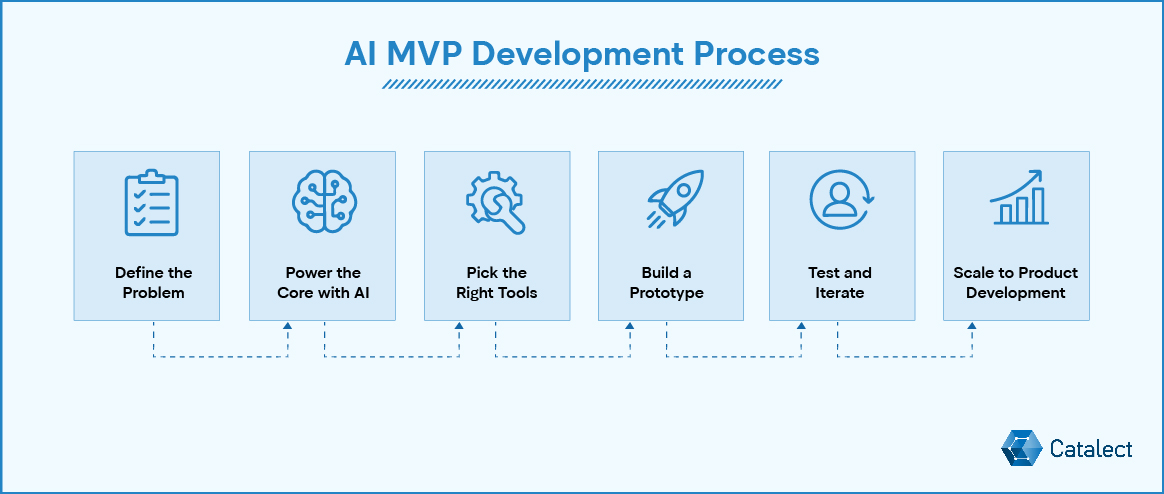Nowadays when every startup is racing to turn ideas into working products, learning how to build an AI MVP has become one of the smartest ways to test, validate, and scale. Instead of investing months into development cycles and large budgets, founders can now launch a lean minimum viable product in AI that delivers real value, gathers feedback from early users, and forms the foundation for long-term growth.
If you are a founder, product manager, or innovation lead wondering how to create an AI MVP that actually works, this guide covers everything you need. We explore AI MVP development from problem definition to prototyping, testing, and scaling. You will learn how to choose the right AI tools for MVP development, design your first intelligent feature, and operate like an effective AI MVP builder.
What Is an AI MVP and Why It Matters for Startups
A traditional minimum viable product tests a concept using the smallest functional version of a product. An AI-powered MVP for startups goes further by placing intelligence at the core. This intelligence can appear in many forms, such as predictive analytics, personalization, natural-language interaction, automation, recommendation systems, or generative text and voice.
Startups benefit from AI MVP development for several reasons. First, it lets you validate your idea faster. Instead of waiting to build an entire product, you release the essential AI-driven capability and observe how users interact with it. Second, it helps control costs because you focus on the feature that matters most. Third, it strengthens differentiation since AI-driven experiences often feel more valuable, more intelligent, and more personalized than standard prototypes. And fourth, it builds data assets early, giving your future product a competitive advantage.
The Role of AI in Modern MVP Development
AI has reshaped the way we build MVPs. Instead of creating static versions for testing, founders now create intelligent and adaptive systems that can learn and improve through usage. This shift has introduced several important changes.
AI now automates tasks that previously required manual effort, such as summarizing content, answering queries, identifying patterns, or generating insights. Prototyping has become much faster because startups can rely on pre-trained models, API-based services, and a broad selection of no-code AI MVP builders. And most importantly, AI introduces continuous value loops, where the system gathers data and improves over time.
However, even though AI adoption is increasing, many companies still find it difficult to achieve measurable impact. This gap between enthusiasm and results is explained in McKinsey’s State of AI report, where they highlight the Generative AI Value Paradox.
The lesson is clear. To succeed, you need a disciplined AI MVP development process, not just AI features added for the sake of novelty.
Industry analysts share similar views. Gartner predicts that foundation models and AI development platforms will shape more than 80 percent of future AI applications. This reinforces that a structured approach to MVP building is essential.
Step-by-Step AI MVP Development Process
Below is a practical roadmap showing how to build AI MVPs for your startup in a structured, manageable way.

Step 1: Define the Problem and Identify the AI Fit
Start by identifying a clear user pain point. This should be specific, measurable, and rooted in real user behaviour. Once the problem is defined, determine whether AI genuinely improves the solution. AI should not be used simply because it is popular. It should add value in the form of personalization, predictions, voice interaction, automation, or pattern recognition.
Define success metrics early. These can include accuracy, response time, conversion improvements, user satisfaction, or engagement levels. By narrowing the scope and validating the problem first, you avoid unnecessary development and stay focused on what truly matters.
Step 2: Use AI to Power the Core Feature
Instead of building multiple features, choose one intelligent component that delivers real value. For example, you may build an AI voice agent that answers common customer questions, or a GPT-powered assistant that summarizes long reports, or a basic predictive engine that recommends relevant items to users.
The goal is simplicity. Ask yourself: What is the smallest AI-powered feature that still solves the problem? This is at the heart of every strong AI-powered MVP for startups.
Step 3: Choose the Right AI Tools and Frameworks
Choosing the right AI stack is one of the most important parts of the AI MVP development process. Most startups begin with pre-trained models such as OpenAI GPT, Hugging Face Transformers, or Google’s AI services because these allow you to prototype quickly without training your own models.
When deciding which model to use, look beyond the headline capabilities. Practical constraints matter. Rate limits differ across providers and can affect whether your MVP can handle real user traffic. At Catalypt, for example, we avoid some models simply because their throughput is too low for production-level testing. Model size and speed also shape the user experience: a smaller model like GPT-4.1-mini may outperform a larger one when latency really matters.
One of the most critical considerations is the context window size. This defines how much text the model can ingest and respond to. If your MVP needs to process long transcripts, documents, or multi-turn conversations, choosing a model with the right context window prevents future limitations.
If speed is essential, a no-code AI MVP builder can also help you experiment quickly. The idea is to get a functional version into users’ hands, not perfect every detail. Keep your architecture simple and modular by separating the model layer, business logic, and interface. This gives you flexibility as your AI MVP evolves.
“An AI MVP succeeds not because of complex algorithms, but because its operational foundations can scale. Throughput, model capacity, and a unified cloud stack ultimately determine whether your AI works in the real world.”
Arham Shahbaz- AI Engineer at Catalect
Step 4: Build a No-Code or Low-Code Prototype
During the MVP phase, progress is more important than perfection. The focus should be on putting a usable version in front of real users instead of architecting a complete, production-ready system. No-code and low-code tools help accelerate this stage by letting you stitch together AI components, build simple workflows, and understand how users interact with your primary feature.
It is also helpful to keep your frontend and backend as consolidated as possible. Using a single cloud ecosystem such as AWS, Azure, or Google Cloud allows you to manage authentication, databases, and model endpoints in one place. This makes the system faster to deploy and more reliable during early testing, since everything lives within one managed environment instead of being spread across multiple services.
Once the prototype is live, release it to a small user group. Focus on feedback, latency, accuracy, and how naturally users interact with the AI component. At this stage, simplicity is your advantage; a smaller, tightly integrated MVP makes it easier to iterate and refine based on what you learn.
Step 5: Test, Learn, and Iterate
Testing is one of the most valuable phases of the AI MVP development process. Gather both qualitative feedback (such as user interviews) and quantitative metrics (such as accuracy, time saved, or task completion rates).
Look for patterns. Users might ask for additional features, highlight confusion points, or reveal when the AI behaves unexpectedly. Use these insights to improve the model, refine interactions, adjust input logic, or revise the user flow.
The strength of an AI MVP is that it improves through iteration. You are not trying to build perfection. You are trying to learn quickly and adapt your AI prototype based on real usage.
Step 6: Prepare for Scale or Full Product Development
If your MVP validates successfully, the next step is building out the full product. This includes enhancing model stability, reducing drift, ensuring data compliance, and preparing infrastructure for larger volumes of traffic.
As AI becomes more central to your solution, you may also explore explainability, reliability, and long-term scalability. Many organizations refer to research such as Gartner’s AI development insights when preparing for full-scale rollout.
Your goal here is simple: turn your validated MVP into a fully operational AI product that can grow sustainably.
Benefits of Building an AI-Powered MVP
Building an AI-powered MVP for startups offers several advantages over traditional MVP approaches. It reduces time to market because you test earlier. It lowers risk by focusing on the validated core. It strengthens product-market fit by gathering real insights. And it highlights competitive differentiation because intelligent features create a strong user experience.
Several real-world examples shared across Medium reinforce this learning. Startups that introduced AI early often validated faster and gained a clearer understanding of user expectations.
Real-World Example Use Cases
Here are three practical examples of how early AI integration can shape a strong MVP:

1. AI voice-based customer support automation
A startup introduces a voice agent that handles common questions and collects user insights. This single feature significantly reduces support load while validating the business model.
2. GPT-powered content assistant
A marketing-tech startup releases a basic writing assistant that generates drafts from simple prompts. Based on feedback, they refine tone, structure, and accuracy before scaling the product.
3. Predictive recommendation engine for e-commerce
A lean MVP uses AI to suggest items users are likely to buy next. This prototype tests the impact of personalization before investing in a full recommendation ecosystem.
These examples illustrate how effective AI MVP development relies on choosing a narrow, high-impact feature and then expanding based on validated results
Common Mistakes to Avoid When Building an AI MVP
Many AI MVPs stumble because the team builds too much too early. It is tempting to add more features or more sophisticated models, but without early validation this only slows you down. Another quiet issue is data quality. When the data is scattered, biased, or simply too thin, the AI behaves unpredictably and founders often mistake this for model failure. And when user feedback is missing, you end up refining assumptions instead of understanding how people actually interact with the product. Even clear success metrics are sometimes overlooked, which makes it difficult to know whether the MVP is progressing or simply existing.
Ethics and compliance also tend to surface late, even though early decisions around privacy, transparency, or bias can shape user trust. By addressing these areas from the start, your AI MVP gains a stronger foundation, which means it not only performs better but is easier to scale into a reliable and market-ready product.
How Catalect Helps Startups Build AI MVPs
At Catalect, we support startups and enterprises in designing and executing their first AI-driven prototypes. As your AI MVP development partner, we help you:
- Validate your core product idea
- Select the right AI tools for MVP development
- Rapidly build your intelligent prototype
- Iterate based on real user behaviour
- Prepare for full-scale product development
To explore how Catalect can support your initiative, visit:
AI Services (Catalect - AI & Technology Services)
AI Products (Products)
These pages outline our approach to AI-powered startup development and how we guide founders from concept to launch-ready innovation.
Final Thoughts
In the current pace-driven world of startups, being first is not enough. Being right matters more. The quality and precision of your AI MVP development process determine how quickly you learn, how effectively you scale, and how confidently you shape your product’s future.
If you want to build AI MVPs that stand out, begin by narrowing the scope, choosing the right AI tools, and focusing on what creates genuine value. Launch your earliest intelligent version, gather insights, and let data lead your next move.
When done correctly, your AI MVP becomes the strongest foundation for future growth.





.jpg)

